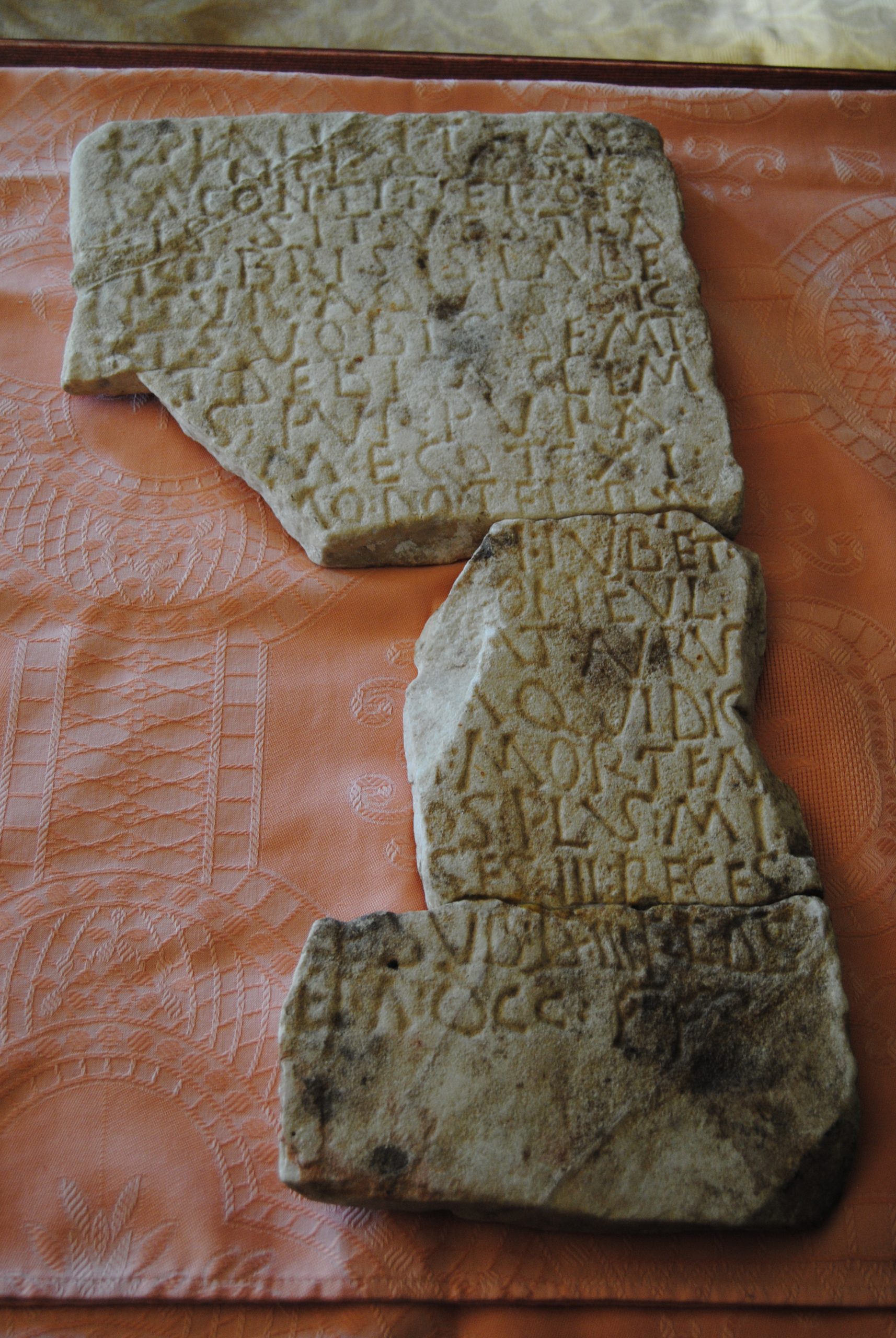SE13
Reference AE 1972, 274 et 275 | Description | Lyrics | Location | Chronology | Epigraphic edition | Translation | Apparatus | Comentary | Type of verse | Text divided into verses and metric signs | Images | Bibliography | Link to DB | Author |
SE13
Description
- Idno filename 22/01/0024
- Type of inscription: Sepulcralis Christ.
- Support: Tablet
- Material: Marble Material Description: White colour.
- Conservation status: Tablet of white marble in three fragments, two of which are joined together. One broken off at the lower left-hand corner, partially affecting ll. 8-11; the lower break affects l. 11, whose letters are completed in the following fragment. Another consists of two adjoining pieces; the break between them is horizontal, mainly affecting the lower part of the antepenultimate line.
- Dimensions height/width/depth (cm): 56.5/30/2.5
-
Epigraphic field:
- Epigraphic field execution: The epigraphic field is undemarcated and not very polished.
- Decoration: An early Christian cross precedes the text.
- Preserved
Lyrics
- Font:Capital rústica
- Letter size:2 and 2,5 cm
- Description of the letters:Rustic capitals. <A> with an oblique crossbar on the left arm; triangular <D>; two rounded <E>s in ll. 2 and 10; the lower stroke of <G> is oblique, separated from the body of the letter; the oblique stroke in <N> does not reach the lower part of the arm. Double vertical interpunction in all cases. Roughly and deeply cut.
Location
- Place of discovery: It was found in fragments (one fragment with ll. 1 to 11 and the other with ll. 12 to 20) at two separate times and places. The earliest information was the discovery of the first fragment in the 1950s in the extension of Calle de Rafael Acuña in Gerena (Sevilla), in ¨a tip in the orchard of Nicomedes¨, which borders on the grounds of the early Christian basilica. From there it was moved to a house in Gerena, where it was used as the lid of a pot for lime. The second fragment was accidentally found circa 1970, and was used as a draining board in a local tavern. The inscription must come from the early Christian basilica in Gerena, although it is not known whether it was inside or outside.
- Geolocation
- Conservation location: Kept in a private collection in Gerena.
- Location with Modern Nomenclature España / Sevilla / Gerena
- Location with Old Nomenclature Hispania / Baetica / Hispalensis
Chronology
- Inscription's dating: From year 662
- Dating explanation: Bearing in mind that Chintasvintus died in 652, the dating of the inscription to 662 assumes a speedy dissemination of the poem by Eugenius of Toledo.
Type of verse
- Type of verse: Dactílico (dístico elegíaco)
- Verse/line correspondence: No
- Prose/verse distinction: No
Epigraphic edition
⊂crux⊃ plan▴gite ▴ me
cun(c)ti ▴ quos ▴ te-
r(r)a ▴ con▴ti▴net ▴ or-
bis ▴ si˹c˺ ▴ vestra
5 pro▴ ˹p˺ri{s}is ▴ labe- (!)
ntur ▴ aquis ▴ sic
X(ris)t(u)s ▴ vobis ▴ de▴m⁽it⁾- ▴( !)
[ta]t ▴ debita ▴ clem-
[e]ns ▴ pur▴pura ▴
10 [que]m ▴ e▴go texi ▴
[iam] mo▴do ▴ terra ▴
[premit no]n ▴ iubet (sic) ▴
[argentum n]on ▴ ˹f˺ul- ▴
[gens adiuv]at ▴ ⁽au⁾▴r⁽um⁾
15 [- – -]a qui dic[-1-]
[- – -]+ ▴ mortem
[ann]os ▴ plus ▴ mi- ▴
[nus] [- – -][men]ses ▴ III ▴ reces- ▴
[sit in pa]ce ▴ sub ▴ d(ie) III K(a)l(en)d(a)s ▴
20 [- – -]era ▴ DCC ▴ ▴▴
Text divided into verses and metric signs
Plangite me cuncti quos terrae continet orbis, lkk|l/l|l/l|ll|lkk|l~
sic vestra propriis <probra> laventur aquis, ll|lkk|l||lkk|lkk|~
sic Christus vobis demit[ta]t debita clem[e]ns, ll|l/l|l/l|ll|lkk|l~
purpura [que]m ego texi, [iam] modo terra [premit], lkk|kkl|l||[l]kk|lkk|~
5 [no]n iuvat [argentum n]on ˹f˺ul[gens adiuv]at aurum. [l]kk|[ll|l]/l|l[l|lk]k|l~
Translation
“Weep for me, all those in the orb of the earth. May your evil actions be cleansed with healing waters. May the merciful Christ forgive your trespasses. He whom I dressed in purple, the earth now [lies upon]; silver gives no pleasure, shining gold gives no pleasure … At the age of approximately ... years and three months, he rested in peace three days before the Kalends.. in the era 700.”
Bibliography
Correa – Pereira 1972, 325–329, n. II (inde AE 1972, 274 et 275 et González Fernández CILA II 1039); Gilsanz 2005, 67–84; Fernández Martínez – Carande, CLEB SE8 et SE9, cum im. phot., quae in linguam Hispanicam verterunt. – Cf. Carande 2010, 219-239.
Comentary
As it was already documented by the first editors, carmen based on a medieval poem by Eugenius of Toledo, the epitaph of Chintasvintus (MGH AA XIV, 250-1) reproducing verses 1 to 3, 18 and 21, though with errors. The distichs quoted are:
1–3: Plangite me cuncti, quos terrae continet orbis,
sic vestra propriis probra laventur aquis,
sic Christus vobis dimittat debita clemens,
18: purpura quem texit, iam modo terra premit.
21: non iuvat argentum, non fulgens adiuvat aurum.
The carmen from Gerena may have been composed for the tomb of a bishop. There are errors in the adaptation of the verses copied, due mainly to carelessness or a lack of education on the part of the cutter.
- 1-4. Plangite me cun<c>ti quos ter<r>a<e> continet orbis, the -c- of cuncti (Bassols 1976, 223–224) and one of the -r in terrae (Väänänen 1975, 109); and the final -e of terrae have been lost. L. 4-6 si⌐c¬ vestra probri{s}is <probra> labentur aquis: sit x sic (cf. Väänänen 1975, 126) a false interpretation of Visigothic t as c. The verse by Eugenius from which this line comes already had lengthening in arsis of the end of vestra followed by initial muta cum liquida; that reappears in this epigraph; and there is betacism in labentur for laventur (cf. Fernández Martínez 1986, 21–25); but the real problem is in that strange pro brisis x propriis probra, to the detriment of the metric and without being able to find a sense to such a sequence, which is quite rare contaminatio between propriis (maybe it was pronounced probriis) and probra in Eugenius poem, propriis aquis seems to mean “with the appropriate waters” ; Correa – Pereira 1972: A skip of the eye might have caused the omission of probra and propriis may have been pronounced probriis. There is an erroneous epenthetic s. Gilsanz 2005 proposes a different reading (sit uestra probr<a> ist<i>s labentur aquis), assuming that the penultimate letter of the sequence PROBRISIS was a <T> and not an <I>; however, as the photograph and autopsy tracing show, there is no sign of a horizontal stroke on the stone.
Ll. 6-9 sic Ch(ris)t(u)s vobis demit[ta]t debita clem[e]ns, this is the most correct verse, almost identical to the original (with the exception of demittat for dimittat). L. 7, until the right edge of the base, demi^t would have been recorded plus a double arbitrary interpunction, and in l. 8 it should replace [ta] (missing because of the break) before the last <l>, which can be read completely. Likewise, at the beginning of l. 9 we have replaced the [e], lost after the break, followed by a probable n. Ll. 9-12 purpura [que]m ego texi, [iam] modo terra [premit]:the verse is immeasurable because of the disruption sufferd after changing, partially, the model og Eugenius poem. There is an obvious restitution: [que]m, and probably [iam] y [premit] in ll. 11- 12. Correa – Pereira 1972 pointed out to two hypothesis for their interpretation: by introducing ego as the subject of texi, purpura became an ablative; or else that ego was provisionally recorded in the draft, waiting to put the name of the deceased, which was never included. Ll. 12-14 [no]n iub⌐a¬t [argentum n]on ⌐f¬ul[gens adiuv]at aurum: Adaptation of l. 21, making it possible to reconstruct the text lost through breakage. Gilsanz 2005 directly reads ful[gens], taking the E to be simply an orthographic variant of F with “four strokes, which can only be differentiated from E by the upper horizontal stroke, more curved than this one and that exceeds on the left the vertical stroke with a finishing pointing downwards”. This is based on the fact that Navascués 1947 pointed out the existence of an F with four strokes (that is, with three horizontal strokes). But in these cases case the top stroke is curved or inclined (occasionally going downwards beyond the foot of the letter), although there is one case where the bottom stroke is inclined. However, as can be seen in the tracing and photograph, none of these features can be detected in our inscription, so it is more likely to be another mistake by the cutter. The word iubet instead of iuvat with betacism and a mistake in the second vowel.
Author
- Author:J. A. Correa Rodríguez, C. Fernández Martínez
- Last Update2024-02-27 11:36:20
- Autopsy date:2010
You can download this





